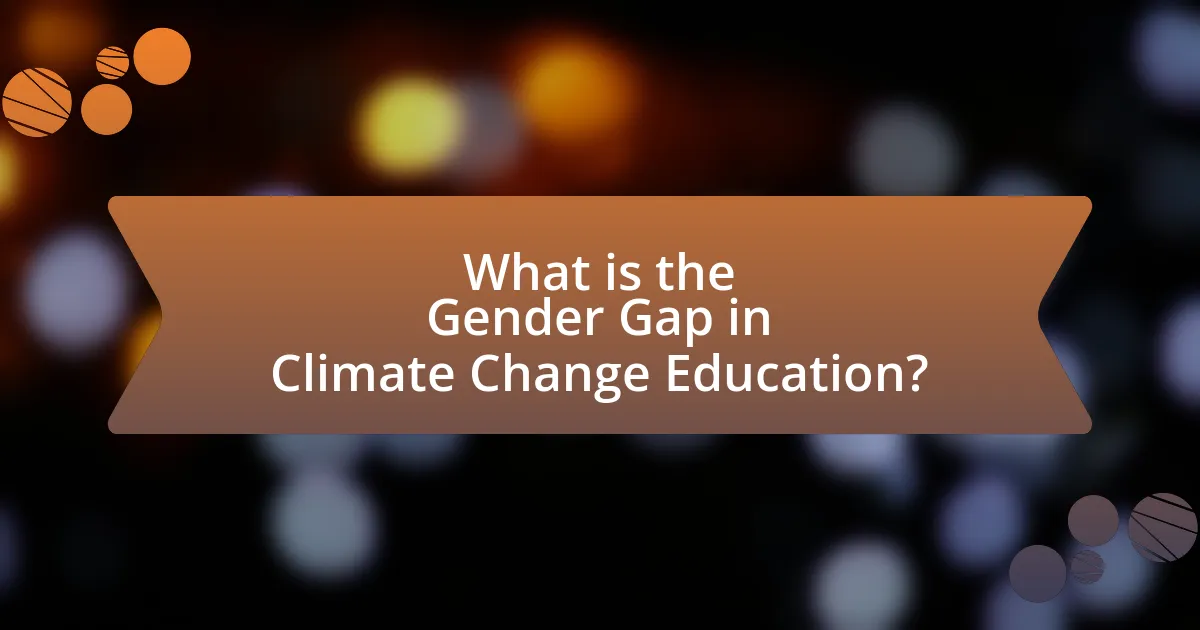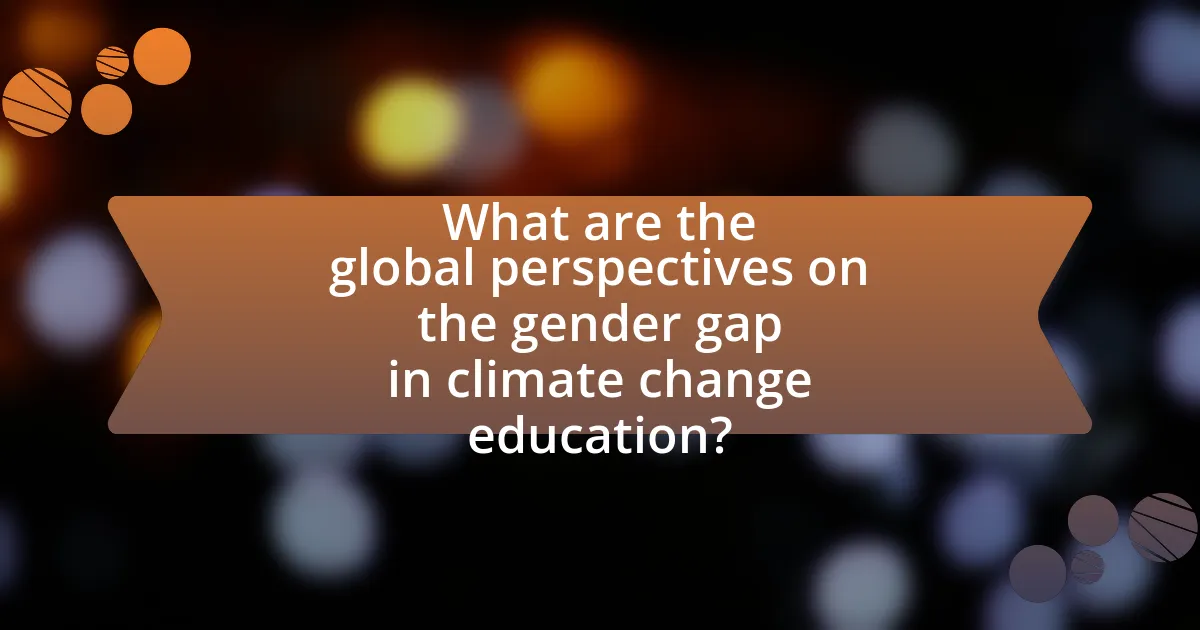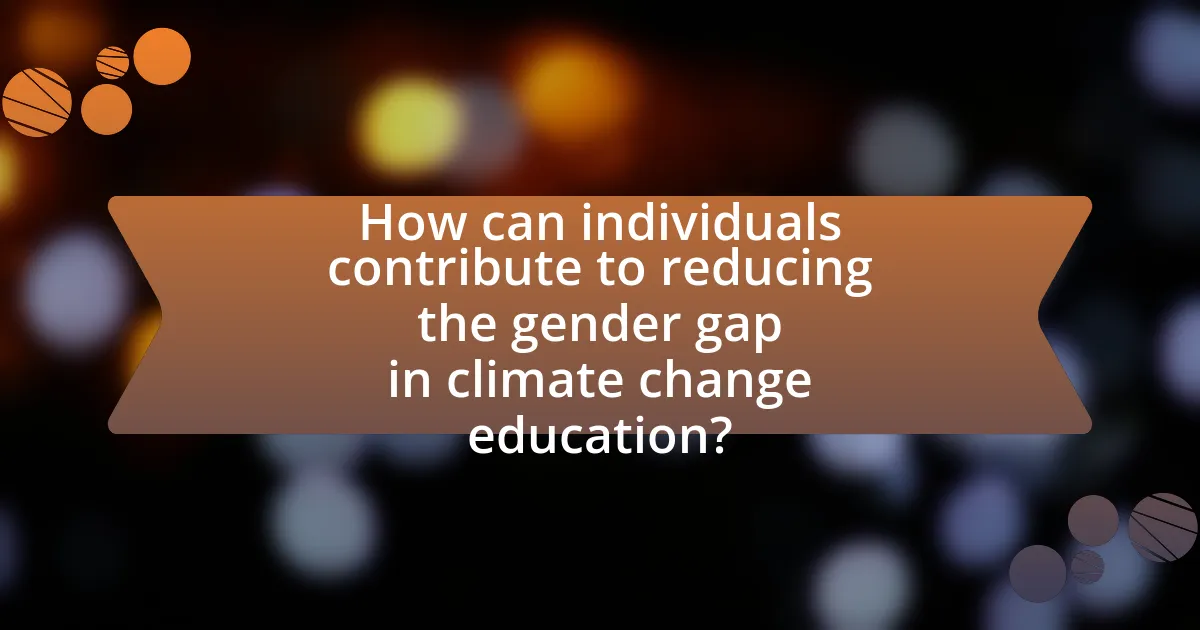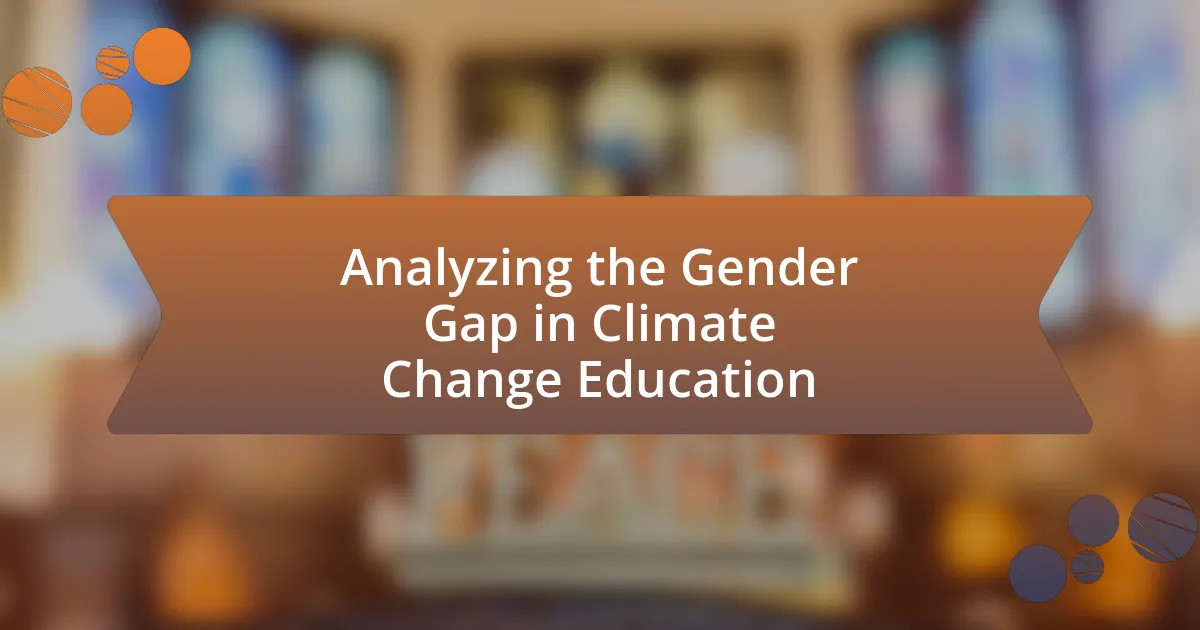The article analyzes the gender gap in climate change education, highlighting the disparities in access, participation, and outcomes between genders, particularly affecting women and girls. It discusses key indicators of this gap, such as enrollment rates in STEM fields, representation in leadership roles, and access to educational resources. The article emphasizes the importance of addressing these disparities to enhance women’s empowerment and improve the effectiveness of climate action. Additionally, it explores the factors contributing to the gender gap, the implications for policy-making, and strategies to promote gender inclusivity in climate education.

What is the Gender Gap in Climate Change Education?
The gender gap in climate change education refers to the disparities in access to climate-related knowledge and resources between different genders, particularly affecting women and girls. Research indicates that women often have less access to education and training in climate science and environmental management, which limits their ability to participate in decision-making processes related to climate change. For instance, a report by UNESCO highlights that girls are less likely to pursue STEM (Science, Technology, Engineering, and Mathematics) education, which is crucial for understanding climate issues. This gap not only hinders women’s empowerment but also affects the effectiveness of climate action, as diverse perspectives are essential for comprehensive solutions.
How is the gender gap defined in the context of climate change education?
The gender gap in the context of climate change education is defined as the disparities in access to, participation in, and outcomes from climate change education programs between different genders. Research indicates that women and girls often face barriers such as socio-cultural norms, limited access to resources, and fewer opportunities for leadership roles in environmental education, which contribute to this gap. For instance, a study by UNESCO highlights that girls are less likely to receive education on climate change compared to boys, impacting their ability to engage in climate action effectively.
What are the key indicators of the gender gap in this field?
The key indicators of the gender gap in climate change education include disparities in enrollment rates, participation in leadership roles, and access to resources. For instance, studies show that female students are often underrepresented in science, technology, engineering, and mathematics (STEM) fields, which are crucial for understanding climate change. According to UNESCO, girls are less likely to pursue higher education in environmental sciences, with only 30% of students in these programs being female. Additionally, women frequently hold fewer leadership positions in climate-related organizations, limiting their influence on policy and education initiatives. Access to educational resources, such as funding and mentorship opportunities, also tends to favor male students, further widening the gender gap in this critical area.
How does the gender gap manifest in different educational settings?
The gender gap in educational settings manifests through disparities in enrollment, participation, and achievement across various disciplines. For instance, in STEM fields, female students often face lower enrollment rates and fewer opportunities for advanced coursework compared to their male counterparts, as evidenced by the National Science Foundation’s report indicating that women earned only 28% of engineering degrees in 2019. Additionally, in climate change education, research shows that female students are less likely to engage in leadership roles or participate in extracurricular activities related to environmental science, which can hinder their overall educational experience and career prospects. This gap is further reflected in classroom dynamics, where gender biases may influence teacher expectations and student interactions, ultimately affecting academic performance and self-efficacy among female students.
Why is it important to analyze the gender gap in climate change education?
Analyzing the gender gap in climate change education is crucial because it reveals disparities in knowledge, access, and participation between genders, which can hinder effective climate action. Research indicates that women often have less access to climate education resources, limiting their ability to contribute to and benefit from climate solutions. For instance, a study by the United Nations Framework Convention on Climate Change (UNFCCC) highlights that women represent only 30% of participants in climate-related decision-making processes. Addressing this gap is essential for fostering inclusive policies and ensuring that all voices are heard in climate discussions, ultimately leading to more effective and equitable climate strategies.
What implications does the gender gap have on climate change awareness?
The gender gap significantly affects climate change awareness, as research indicates that women often have less access to education and resources related to environmental issues compared to men. This disparity leads to lower levels of awareness and engagement in climate action among women. For instance, a study by the United Nations Development Programme found that women are disproportionately affected by climate change impacts, yet they are underrepresented in decision-making processes, which limits their ability to influence climate policies. Furthermore, the Global Gender and Climate Alliance highlights that empowering women through education can enhance community resilience to climate change, demonstrating that bridging the gender gap can lead to more effective climate action and awareness.
How does the gender gap affect policy-making and climate action?
The gender gap significantly affects policy-making and climate action by limiting the representation and participation of women in decision-making processes. Research indicates that women’s involvement in climate policy leads to more comprehensive and effective solutions, as they often prioritize sustainability and community resilience. For instance, a study by the United Nations Development Programme found that countries with higher female representation in government are more likely to adopt climate policies that address gender-specific vulnerabilities. This correlation highlights how the gender gap can hinder the development of inclusive climate strategies, ultimately impacting the effectiveness of climate action initiatives.
What factors contribute to the gender gap in climate change education?
The gender gap in climate change education is primarily influenced by socio-cultural norms, access to resources, and educational opportunities. Socio-cultural norms often dictate gender roles, leading to disparities in engagement and participation in environmental education programs. For instance, research indicates that girls may receive less encouragement to pursue science and environmental studies compared to boys, limiting their exposure and interest in climate change topics. Additionally, access to educational resources, such as technology and funding for programs, often favors boys, further widening the gap. A study by the United Nations Educational, Scientific and Cultural Organization (UNESCO) highlights that girls are less likely to have access to quality education in STEM fields, which are crucial for understanding climate science. These factors collectively contribute to the persistent gender gap in climate change education.
How do cultural attitudes influence the gender gap?
Cultural attitudes significantly influence the gender gap by shaping perceptions of gender roles and expectations within society. For instance, in many cultures, traditional views prioritize male dominance in education and professional fields, leading to lower participation rates of women in climate change education and related sectors. Research indicates that countries with progressive gender norms, such as those in Scandinavia, exhibit smaller gender gaps in education and employment, highlighting the impact of cultural attitudes on women’s access to opportunities. Furthermore, studies show that when cultural attitudes promote gender equality, women are more likely to pursue careers in science, technology, engineering, and mathematics (STEM), which are crucial for addressing climate change challenges.
What role do educational resources play in perpetuating the gender gap?
Educational resources significantly contribute to perpetuating the gender gap by often reflecting and reinforcing societal biases that disadvantage women and girls. For instance, research indicates that educational materials frequently lack gender-sensitive content, which can lead to lower engagement and achievement among female students. A study by UNESCO found that in many countries, textbooks and curricula predominantly feature male figures and perspectives, thereby marginalizing women’s contributions and experiences. This lack of representation can discourage girls from pursuing subjects like science and technology, which are crucial for addressing climate change. Consequently, the underrepresentation of women in these fields perpetuates the gender gap in climate change education and broader environmental decision-making.
How can we measure the impact of the gender gap in climate change education?
The impact of the gender gap in climate change education can be measured through quantitative assessments of educational outcomes and participation rates among different genders. For instance, analyzing enrollment statistics in climate-related courses reveals disparities in gender representation, while surveys can gauge knowledge levels and attitudes towards climate change among male and female students. Research indicates that women are often underrepresented in STEM fields, which directly affects their engagement in climate education; for example, a UNESCO report highlights that only 30% of the world’s researchers are women, impacting their contributions to climate science. Additionally, evaluating the effectiveness of educational programs through gender-disaggregated data can provide insights into how educational interventions may need to be tailored to bridge the gap.
What strategies can be implemented to bridge the gender gap in climate change education?
To bridge the gender gap in climate change education, targeted strategies such as integrating gender-sensitive curricula, promoting female role models in environmental sciences, and enhancing access to resources for girls are essential. Research indicates that educational programs that incorporate gender perspectives can significantly improve engagement and understanding among female students. For instance, the United Nations Educational, Scientific and Cultural Organization (UNESCO) emphasizes the importance of gender-responsive teaching methods, which can lead to increased participation of girls in climate-related subjects. Additionally, initiatives that provide scholarships and mentorship for young women in environmental fields have been shown to encourage their involvement and leadership in climate action.
How can educational institutions promote gender equality in climate education?
Educational institutions can promote gender equality in climate education by integrating gender perspectives into their curricula and fostering inclusive participation in climate-related activities. This approach ensures that both male and female students engage equally in discussions and projects related to climate change, thereby addressing the existing gender disparities in environmental education. Research indicates that women are often underrepresented in environmental science fields, which can be mitigated by implementing programs that encourage female students to pursue studies and careers in this area. For instance, the United Nations Educational, Scientific and Cultural Organization (UNESCO) emphasizes the importance of gender-sensitive teaching methods and materials to create an equitable learning environment. By actively promoting female role models in climate science and providing scholarships or mentorship programs specifically for women, educational institutions can further enhance gender equality in climate education.
What role do community programs play in addressing the gender gap?
Community programs play a crucial role in addressing the gender gap by providing targeted educational resources and support tailored to women and girls. These programs often focus on empowering participants through skills training, mentorship, and access to information related to climate change, which is essential for fostering gender equity in this field. For instance, initiatives like the Women’s Environmental Network have demonstrated that when women are engaged in climate education, they are more likely to take leadership roles in sustainability efforts, thereby reducing the gender gap. Additionally, research shows that communities with active gender-focused programs see increased participation of women in environmental decision-making, which further highlights the effectiveness of these programs in bridging the gender divide.

What are the global perspectives on the gender gap in climate change education?
Global perspectives on the gender gap in climate change education highlight significant disparities in access and participation between genders. Research indicates that women and girls often face barriers such as socio-cultural norms, lack of resources, and limited representation in decision-making roles related to climate education. For instance, a report by UNESCO in 2021 revealed that girls are less likely to receive education in science, technology, engineering, and mathematics (STEM), which are critical for understanding climate change. Additionally, the Global Gender and Climate Alliance emphasizes that empowering women through education can enhance community resilience to climate impacts, suggesting that addressing the gender gap is essential for effective climate action.
How does the gender gap vary across different regions?
The gender gap varies significantly across different regions, with some areas exhibiting wider disparities than others. For instance, in Sub-Saharan Africa, women often have limited access to education and resources, resulting in a pronounced gender gap in climate change education. In contrast, regions like North America and Western Europe show smaller gaps due to higher levels of educational attainment and gender equality initiatives. According to the Global Gender Gap Report 2021 by the World Economic Forum, countries such as Iceland and Finland have nearly closed the gender gap, while countries like Yemen and Pakistan rank among the lowest, highlighting the stark regional differences in gender equality and access to education.
What are the unique challenges faced by women in developing countries regarding climate education?
Women in developing countries face unique challenges regarding climate education, primarily due to socio-economic barriers, cultural norms, and limited access to resources. These challenges include lower levels of formal education, which restrict their understanding of climate issues, and traditional gender roles that prioritize domestic responsibilities over educational pursuits. Additionally, women often lack access to technology and information networks that facilitate climate education, further exacerbating their exclusion from climate-related decision-making processes. According to a report by the United Nations Development Programme, women in rural areas are disproportionately affected by climate change impacts, yet they are underrepresented in climate education initiatives, highlighting the urgent need for targeted interventions to address these disparities.
How do developed nations address the gender gap in climate change education?
Developed nations address the gender gap in climate change education by implementing targeted educational programs and policies that promote gender equality in environmental science and climate literacy. For instance, countries like Sweden and Canada have integrated gender perspectives into their climate education curricula, ensuring that both boys and girls receive equal opportunities to engage with climate issues. Additionally, initiatives such as the United Nations’ Gender and Climate Change Initiative emphasize the importance of women’s participation in climate education and decision-making processes, highlighting that women are often disproportionately affected by climate change. Research indicates that when women are educated about climate change, they are more likely to contribute to sustainable practices and community resilience, thereby reinforcing the need for gender-inclusive educational strategies.
What initiatives exist to reduce the gender gap in climate change education?
Several initiatives aim to reduce the gender gap in climate change education, including the Gender and Climate Change Working Group, which focuses on integrating gender perspectives into climate education curricula. Additionally, organizations like UN Women and the Global Environment Facility promote programs that empower women through education on climate issues. Research indicates that women are disproportionately affected by climate change, and targeted educational initiatives can enhance their capacity to respond effectively. For example, the “Women and Climate Change” initiative by the United Nations emphasizes the importance of women’s participation in climate education to foster sustainable development.
What are some successful case studies from around the world?
Successful case studies in addressing the gender gap in climate change education include the “Girls Leading the Way” initiative in Kenya, which empowered young women through climate education and leadership training, resulting in increased community engagement and advocacy for sustainable practices. Another example is the “Climate Change and Gender” project in Bangladesh, which integrated gender-sensitive approaches into climate education, leading to improved resilience among women in rural areas. These case studies demonstrate effective strategies for bridging the gender gap and enhancing climate change education globally.
How do international organizations contribute to closing the gender gap?
International organizations contribute to closing the gender gap by implementing policies and programs that promote gender equality in various sectors, including education, health, and economic opportunities. For instance, the United Nations Entity for Gender Equality and the Empowerment of Women (UN Women) actively supports initiatives that enhance women’s access to education and resources, which are crucial for addressing the gender gap. According to the World Economic Forum’s Global Gender Gap Report 2021, countries with strong international organization involvement have shown significant improvements in closing the gender gap, particularly in educational attainment and economic participation. These organizations also provide funding and technical assistance to local governments, enabling them to create gender-sensitive policies that foster equality and empower women in climate change education and other critical areas.
What future trends can we expect regarding the gender gap in climate change education?
Future trends indicate a narrowing of the gender gap in climate change education, driven by increased awareness and targeted initiatives. Research shows that educational programs focusing on climate change are increasingly incorporating gender perspectives, which enhances female participation. For instance, the United Nations Educational, Scientific and Cultural Organization (UNESCO) reported in 2021 that gender-responsive education strategies have led to a 15% increase in female enrollment in environmental science courses globally. Additionally, grassroots movements and international collaborations are promoting female leadership in climate education, further contributing to this trend.
How might technological advancements influence gender equality in climate education?
Technological advancements can significantly enhance gender equality in climate education by providing equitable access to resources and learning opportunities. For instance, online platforms and mobile applications can reach marginalized groups, including women in remote areas, enabling them to access climate education materials that were previously unavailable. According to a report by UNESCO, digital learning tools can help bridge educational gaps, particularly in regions where traditional educational infrastructure is lacking. Furthermore, technology facilitates collaborative learning environments, allowing women to engage in discussions and projects related to climate change, thereby empowering them to take active roles in environmental decision-making.
What role will policy changes play in shaping the future of climate change education?
Policy changes will significantly enhance the effectiveness and accessibility of climate change education. By implementing policies that prioritize climate literacy in school curricula, governments can ensure that students receive comprehensive education on climate issues, fostering a more informed and proactive generation. For instance, the integration of climate change topics into educational standards has been shown to improve student engagement and understanding, as evidenced by the Next Generation Science Standards adopted in the United States, which emphasize climate science. Furthermore, policies that allocate funding for teacher training and resources can bridge the gender gap in climate education, ensuring that both male and female students receive equal opportunities to learn about and address climate challenges.

How can individuals contribute to reducing the gender gap in climate change education?
Individuals can contribute to reducing the gender gap in climate change education by actively promoting inclusive educational practices and supporting female participation in climate-related programs. Research indicates that women are underrepresented in climate science and education, with only 30% of researchers in climate-related fields being female. By mentoring young women, advocating for gender-sensitive curricula, and participating in community outreach, individuals can help create an environment that encourages equal access to climate education for all genders. Additionally, supporting organizations that focus on empowering women in environmental education can further bridge this gap.
What actions can educators take to promote gender inclusivity in their curriculum?
Educators can promote gender inclusivity in their curriculum by integrating diverse perspectives and materials that reflect the contributions of all genders in climate change education. This can be achieved by selecting texts, case studies, and examples that highlight the roles of women and non-binary individuals in environmental science and activism, thereby ensuring representation. Research indicates that inclusive curricula can enhance engagement and learning outcomes for all students, as demonstrated in studies showing that diverse educational content fosters critical thinking and empathy (Gonzalez, 2020, Journal of Educational Research). Additionally, educators should encourage collaborative projects that allow students to explore gender issues related to climate change, facilitating discussions that challenge stereotypes and promote equity.
How can students advocate for gender equality in climate education?
Students can advocate for gender equality in climate education by actively participating in awareness campaigns and educational initiatives that highlight the importance of inclusive climate policies. Engaging in discussions, organizing workshops, and collaborating with organizations focused on gender and climate issues can amplify their voices. Research indicates that women are disproportionately affected by climate change, as noted in the United Nations Framework Convention on Climate Change reports, which emphasize the need for gender-responsive approaches in climate education. By promoting these initiatives, students can help ensure that both genders are represented and empowered in climate-related decision-making processes.
What resources are available for individuals looking to support gender equality in this field?
Individuals looking to support gender equality in climate change education can access various resources, including organizations, online platforms, and educational materials. Notable organizations such as UN Women and the Global Gender and Climate Alliance provide reports, toolkits, and advocacy resources focused on integrating gender perspectives into climate policies. Online platforms like Gender and Climate Change Hub offer a repository of research, case studies, and best practices that highlight the intersection of gender and climate issues. Additionally, educational materials from institutions like the International Institute for Environment and Development emphasize gender-responsive approaches in climate education, equipping individuals with knowledge and strategies to promote equality in this field.
What best practices can be adopted to ensure equitable climate change education for all genders?
To ensure equitable climate change education for all genders, educational programs must incorporate gender-sensitive curricula that address the unique experiences and contributions of different genders in climate issues. This approach includes actively involving diverse gender perspectives in the development of educational materials and ensuring equal access to resources and opportunities for all genders. Research indicates that gender-responsive education can enhance learning outcomes and foster greater engagement in climate action, as evidenced by initiatives like the United Nations’ Gender and Climate Change Framework, which emphasizes the importance of integrating gender considerations into climate education.
How can collaboration between genders enhance climate change education?
Collaboration between genders can enhance climate change education by integrating diverse perspectives and experiences, which leads to more comprehensive understanding and solutions. Research indicates that gender-diverse teams are more innovative and effective in problem-solving, as they draw from a wider range of insights and approaches. For instance, a study published in the journal “Nature” found that organizations with gender diversity in leadership positions are more likely to prioritize sustainability initiatives. This collaborative approach not only enriches the educational content but also fosters an inclusive environment that encourages participation from all genders, ultimately leading to more effective climate action strategies.
What role does mentorship play in bridging the gender gap in climate education?
Mentorship plays a crucial role in bridging the gender gap in climate education by providing guidance, support, and networking opportunities for women and girls. Research indicates that mentorship enhances confidence and skill development, which are essential for participation in climate-related fields. For instance, a study by the United Nations Environment Programme highlights that mentorship programs can significantly increase the representation of women in environmental leadership roles, thereby addressing the gender disparity in climate education. By fostering relationships between experienced professionals and emerging female leaders, mentorship not only empowers individuals but also contributes to a more inclusive and diverse climate education landscape.
